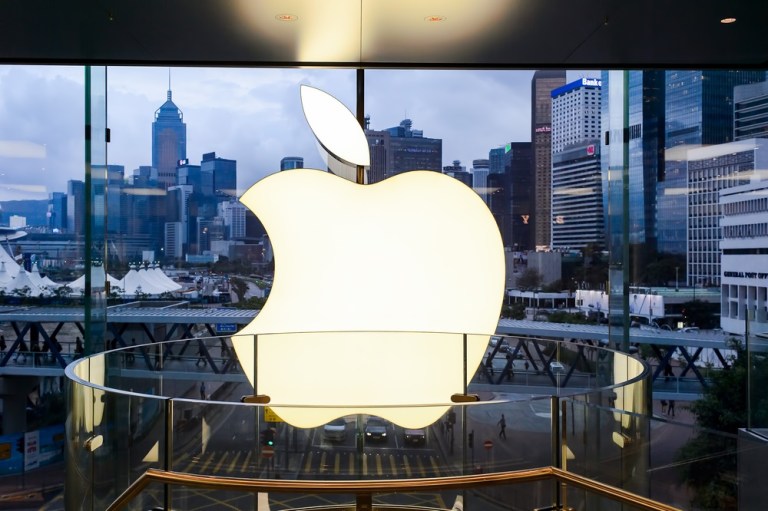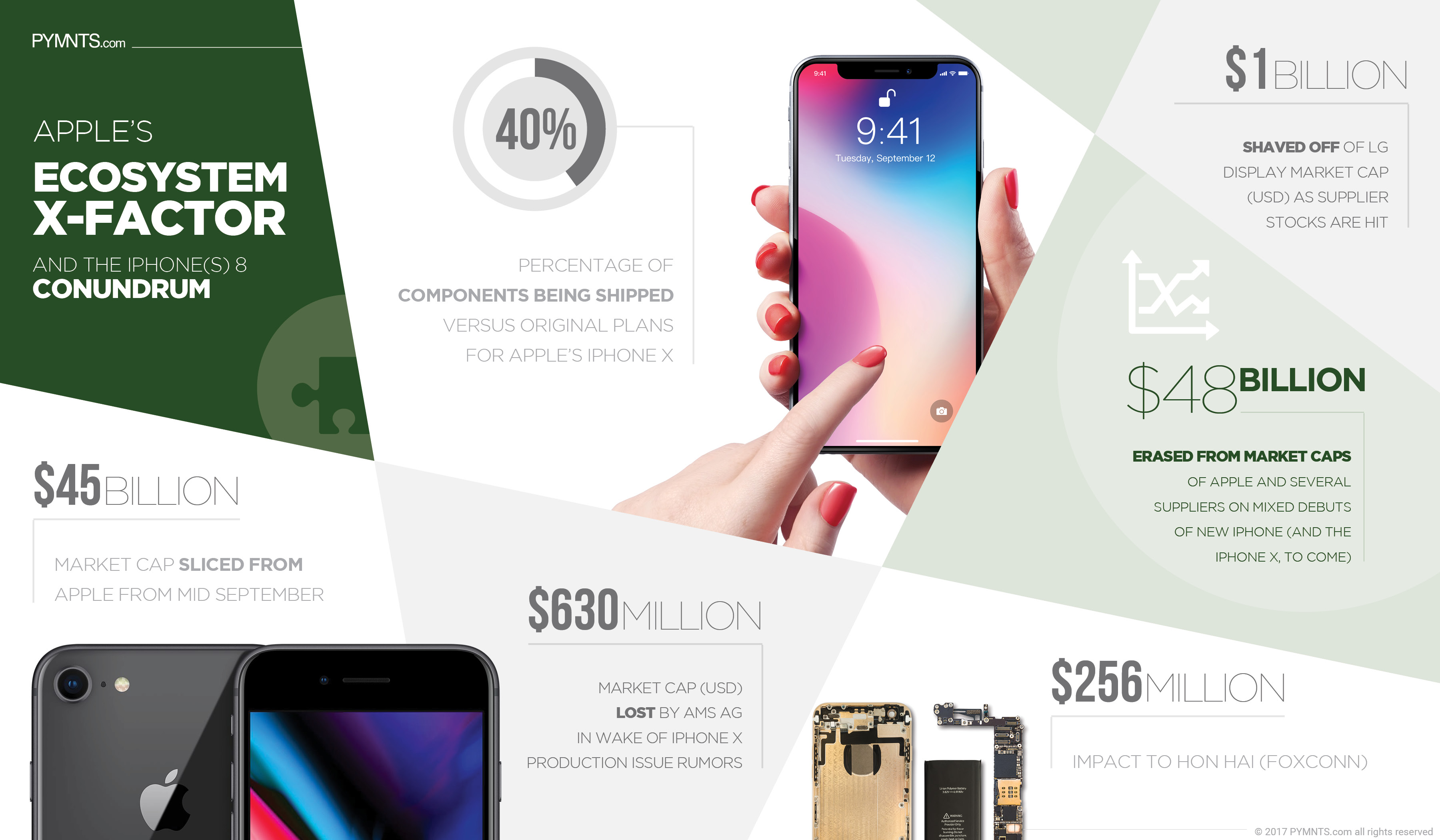Apple’s $48B Dent In The Supplier Universe

Call it the “X Factor.”
Apple’s X Factor, to be precise. And that Factor has taken a bit of a toll on the Apple ecosystem, to the tune of several billion dollars — along with tepid news and reviews about the iPhone 8 series that is just now hitting shelves.
More than $48 billion dollars, in fact.
That’s quantified by a few moving parts, among them Apple shares and the shares of some of its major suppliers. Apple shares are trading at $154, having come in from roughly $162 since mid-September, when details began truly emerging about the iPhone 8(s) and the upcoming iPhone X (more on that in a bit). There are roughly 5.6 billion Apple shares outstanding, indicating a nearly $45 billion impact on an $8 slide.
The company, its stock and by extension its supply chain have seen a spate of bumps in the past several days as the news came that demand for the newest, upcoming, yet-to-hit-the-market smartphone would be less than stellar.
That, at least, was the verdict widely accepted on Wall Street following a report via Digitimes. The tech publication said Monday that Apple was taking only a relatively small percentage of components from suppliers — 40 percent, to put a headline number on it.
Generally speaking, when a company outsources production of the nuts and bolts of the gadgets it sells, it pays to gauge the health of the supply chain, in terms of throughput (and Digitimes did take note that low yields in production may be the culprit).
Still, if a firm tells its partners that it wants deliveries to slow or wants to take a small percentage of what’s been originally ordered … there might be trouble ahead.
Suppliers Supply Some Downside to the Apple Ecosystem
Thus, some additional impact to the Apple ecosystem, speaking down the line, in terms of the supply line. Hon Hai Precision, which helps assemble Apple’s hardware, as Foxconn, has slipped from $92 Tawainese dollars to about $86.50 in just the past several sessions, to a net impact of $256 million. LG Display, which makes, well, the displays, has seen shares slip by 10 percent to 30,550 KRW from recent peaks north of 34,000, hitting the ecosystem by more than $1 billion. Goertek, which makes acoustic parts, has declined from 21 yuan to a recent 19, slicing almost $1 billion off the chain of command (in market cap).
So, when Apple sneezes, other folks catch a cold.
The supply chain idea is not to flood the market with finished product that then sits on store shelves. Put only a small amount of product out there — be it toys or widgets or, in this case, smartphones — and then you’ll gauge consumer demand with relatively less risk to the bottom line (and to headlines, of course).
No one likes negative press that says the newest hot item is a dud. If the shelves start to clear, pricing stays steady. Profits do too. And should demand pick up, to quote and paraphrase an old snack food commercial (Doritos — no need to Google it): Buy all you want. They’ll make more.
But then again: With a spate of new devices hitting the market and the Digitimes article in place, the conventional wisdom seemed to be (earlier this week, at least) that demand for the iPhone X was weak, more than a month before its launch. Perhaps the looming $999 price tag has something to do with it?
One more wrinkle — and this one has little to do with demand: The iPhone X has Face ID, powered in part by a 3-D sensor that reportedly is facing some production difficulties, as detailed in a Nikkei Asian Review article and as cited by CNET. The production delays may (or may not) be enough to push out the initial and official debut in stores of the iPhone X. That was confirmed by a spate of additional reports on Wednesday, with Austrian sensor maker ams AG stock having come off from 77 as a peak to a recent 69 and change, taking about the same off the Apple ecosystem value (as shares are listed on the Swiss exchanges). There’s rough parity between the Swiss franc and the dollar, so the impact here is about $630 million.
Cirrus Logic makes audio chips for iPhones, and its price has slipped 6 percent, with the impact at about $300 million. Analog Devices, which makes touchscreen controllers, has been roughly flat.
From just these six suppliers alone (and the company has hundreds of suppliers), the impact is about $3.3 billion in market cap, tied to Apple’s possible iPhone ennui.
Not the best thing to hear when other phones, such as the iPhone 8 and iPhone 8 Plus were not getting rave reviews. But more on that in a minute. Let’s finish the discussion of the iPhone X supply chain debate.
Barring any real production glitches, take that aforementioned 40 percent supply chain number with a grain of salt. Consider the fact that Apple has done this before. The iPhone 7 got a similar component pullback last year, as Digitimes reported, with a throttle back to 60 percent of initial orders. Then, when sales were strong enough, production went back to full tilt.
The same consideration — that this may be prudent management — shows up in the stock. The shares have rebounded as noted before. In this way, the grain of salt was swallowed and investors have seemingly moved on.
The phones to still keep an eye on are the iPhone 8 series, where the newest models went on sale into the weekend. The smartphones, you may remember, were introduced earlier in September, and, with the first weekend of data out there, the initial indications are … hazy.
For iPhones 8, a Slow Start…
One firm, Localytics, said that — as measured by users who got their smartphones and are using mobile apps on them across 70 million iOS devices — adoption has been “predictably slow.” The iPhone 8 has 0.3 percent of device market share, while the Plus has 0.4 percent.
Stalwarts in the field include the iPhone 6S, with 19.3 percent share, and the iPhone 7, with 19.2 percent, but then again, they’ve had time to mature in the field, so to speak. By way of comparison, the site noted, the 7 grabbed 1 percent of adoption in its first weekend last year, while the 6 had a 2 percent slice of the pie in 2015 when it hit the market.
OK, one weekend does not a trend make. We need to triangulate some other sources. At least one Wall Street Analyst, Ming-Chi Kuo, from KGI Securities, has said that iPhone X pre-orders could be around 50 million units at the end of October and into an early November debut. That supply chain prudence, then, might look conservative, as Apple may have to scramble to keep up with demand.
For Apple, this selling season is a little off the beaten path, with three flagship devices hitting the market in a relatively short time. Might cannibalization be in the works?
…leads to iPhone 8’s Loss, iPhone X’s Gain?
Perhaps so. Perhaps the 8’s loss will be the X’s gain. Coming into the weekend, The Wall Street Journal reported, slow iPhone sales may, in fact, presage a surge in demand for the X. Call it a wait and see attitude. With the Chinese market serving as barometer — the Wall Street Journal noted it’s one of Apple’s most important markets — the demand is “tepid, and some analysts say that could be a good thing” for the company, especially for the iPhone X. One analyst spotlighted by the WSJ, Katy Huberty of Morgan Stanley, has noted that the muted 8 reaction may auger well for the X and for the overall bottom line of Apple as a company. There’s a higher price point for the X (by a few hundred dollars versus the 8s, both in China and in the U.S., where the smartphones start at $699 for the 8 and $799 for the 8 Plus), which drops down to the operating profit line.
However, the production delays coming out in the financial and technology trade press might be a bit bracing. The X factors heavily into sell-side forecasts for double-digit growth (in unit sales) on Wall Street moving forward.
Overall, said the WSJ, analysts see 245 million iPhones likely to be sold in fiscal year 2018, up 13 percent from the previous year (fiscal years end on Sept. 30). The estimates include projections that the iPhone X will be as much as 45 percent of that tally, as measured by unit sales, and the 8s will be 47 percent.
For quarterly estimates, Apple has said that its own top line would be $49 billion to $52 billion for the period that ends in September (as in, this week). Those estimates have baked in a bit of iPhone 8 contribution, and one wonders if that contribution will be as robust as had been hoped (thus a miss might loom when earnings are reported). Consider the fact that Fortune has said that days after preorders were available, the smartphones were still available, where past iterations of the iPhone have sold out in minutes.
In the latest news, as in Wednesday’s news, Raymond James said it is now seeing a “surprising demand for the X over the 8” that trumps price. Research from that firm says 37 percent of surveyed customers think they will upgrade their iPhones through the next 12 months, versus 44 percent in the three years past. Of that, 46 percent think they’ll upgrade to the X, which, of course, will have a positive impact on margins and earnings and thus, likely, share price. (The analyst, Tavis McCourt, boosted his price target to $190 from $180).
Hmm. To be trumped by the X? Rough initial sledding for the 8s. (“X Factor” indeed.) To take a line from another X — this time, the “X-Files” — the truth is out there. We just don’t know what it is. Yet.
